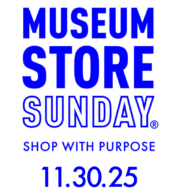American Artist Appreciation Month Series
Peter Seltzer didn’t set out to become an artist, but somewhere between his career as a park ranger and adventures around the globe, he discovered a love for creating small objects that tell big stories.
As the founder of Pete’s Papercrafts in New Orleans, Seltzer’s laser-cut cardboard landmarks and glittering earrings capture the spirit of place, culture, and community. From king-cake earrings to mini monuments, his work blends heritage and humor, proving that even the smallest designs can spark lasting connections and conversations.
We met with Seltzer to learn how his playful, precision-crafted pieces have become customer favorites at the Museum of the Southern Jewish Experience Store. Continue reading to learn more about his work and journey as an artist as part of our American Artist Appreciation Month series.

Museum Store Sunday (MSS): Hi Peter! It’s nice to meet you. Can you tell us about yourself and your journey as an artist?
Peter Seltzer (PS): I’m a former park ranger turned artist-maker who fell in love with laser-cutting. Today, I run Pete’s Papercrafts in New Orleans, where my team and I transform layered cardboard into precision 3-D dioramas of beloved landmarks, from Café du Monde to the U.S. Supreme Court.
Our mission is simple: make architecture—and the stories behind it—feel hands-on, affordable, and fun.
MSS: Who inspired you to become an artist?
PS: A lifetime of travel—especially a formative solo trip through Japan’s gardens, temples, and meticulous gift shops—taught me that small, well-crafted objects can capture an entire place and moment. That same impulse, paired with my Jewish heritage, later drove me to design modern Judaica when I realized how little playful, contemporary work existed on the market.
MSS: Speaking of small, well-crafted objects, tell us about the earrings you design that can be found at the Museum of the Southern Jewish Experience Store.
PS: The featured items are my laser-cut acrylic earrings—tiny challah breads, glittery dreidels, king-cake slices, and other joyful icons that mix Judaica with New-Orleans flair. I launched the line because friends kept asking for gifts that felt both proudly Jewish and fun. When the Museum of the Southern Jewish Experience opened, their buyer immediately saw the fit and encouraged me to push the collection further.

Mardi Gras Earrings (Left) and Blue Sparkle Star of David Earrings (Right) by Peter Seltzer
MSS: How do you make the earrings? Walk us through the process.
PS: I start by asking, “What emotion or memory should this piece spark?”, then rough the silhouette in Adobe Illustrator. The sketch is vectored in Illustrator, adding depth lines so the light catches like real bread braid or bead sparkle.
My in-house collection of laser cutters and UV printers adds color gradients when needed.
Every piece is assembled with hypoallergenic surgical-steel findings, cleaned, and carded.
The entire shop runs on solar panels; off-cut acrylic is recycled into test swatches.
MSS: What do customers love most about your designs?
PS: People spot the challah or king-cake slice and laugh before asking, “Wait, are those what I think they are?” Wearers say strangers strike up chats about Jewish food, Mardi Gras, or New Orleans stories. Tiny engraved salt crystals on the pretzel earrings or a micro “braid” on the challah reward a closer look.
Handmade in New Orleans with solar power, shoppers feel good about the purchase, too.
MSS: Why is it important for shoppers to support local artists?
PS: Every dollar spent with an artist-maker recirculates in the community through fair wages, local suppliers, and new cultural programming. In museum stores, that support is amplified: the artist’s revenue sustains the museum, and the museum’s curatorial voice gives the artist a national platform. It’s a virtuous loop of creativity and stewardship.
MSS: Tell us about your relationship with the Museum of the Southern Jewish Experience Store, where museum visitors can find your earrings.
PS: I’ve been involved with the Museum of the Southern Jewish Experience since before its doors opened—first as an eager community member, now as both vendor and creative partner.

DIY Paper Craft Diorama: MSJE Peddlers and Merchants, Custom-Designed for the Museum of the Southern Jewish Experience Store by Peter Seltzer
Beyond stocking my earrings, their development team collaborates with me on limited-edition gifts for donors and board members. I even lend a hand to curators when an exhibit needs a laser-cut component. Their faith in my work validates the idea that modern, playful Judaica has a rightful place in telling the Southern Jewish story.
MSS: Share your favorite museum store-related memory.
PS: My favorite moments happen quietly: I’ll drop off new inventory—or just browse incognito—and spot a visitor turning my papercraft or earrings over in their hands, puzzled and smiling as they figure out what it is.
I linger a few steps away to watch the discovery unfold. Then I’ll lean in and say, half-teasing, “Those are pretty cool, huh?” When they agree, I reveal, “I actually made them.” Their surprise usually flips to delight and a flood of questions. It’s the perfect reminder that the work connects strangers long before I ever introduce myself.
MSS: Where can people follow you on your journey as an artist?
PS: They can follow me on Instagram (@petespapercrafts) and Facebook.
Support Local Artists Like Peter Seltzer in Your Community
If you’re looking for a thoughtful way to support creativity and community, pay a visit to your local museum store. Whether it’s artisan-made jewelry, beautifully designed accessories, or imaginative books and toys, every purchase helps support the artists and makers in your neighborhood.
More than a souvenir, your purchases fuel museum programs, boost local economies, and create a strong sense of community pride.
Ready to shop with purpose all year round? Use our store locator to find a museum store near you. And be sure to mark your calendar: Museum Store Sunday returns on November 30, 2025, with exclusive products, artist appearances, and unique holiday gifts you won’t want to miss.

